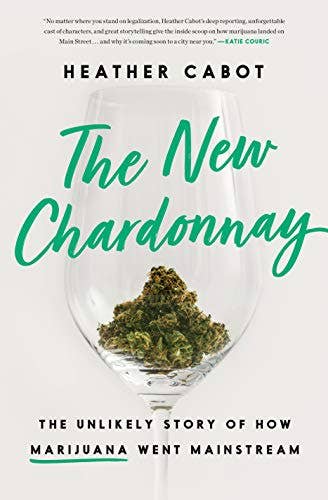
Journalist Heather Cabot’s latest book, The New Chardonnay: The Unlikely Story of How Marijuana Went Mainstream, is definitely not about expanding your ability to choose a new white wine. It’s actually a detailed look at how cannabis has gone from an illicit substance, listed as a federally prohibited Schedule 1 drug, to the basis of a multimillion-dollar industry that seemingly draws more entrepreneurs every week.
How the times have changed. One in five Americans can now walk into a dispensary to purchase cannabis. Suburban moms take THC-laced popcorn in between their kids’ soccer practices, use CBD lubes at night, and have parties exchanging Tupperware full of edibles on the weekends. Grandma is at the rest home, getting some CBD lotion to rub on her arthritic hands. And dispensaries look like Apple store impersonators.
How did we get here?
Cabot’s book focuses on four main characters. First, there’s Beth Stavola, a former Wall Street executive who decides, after retiring, to invest in marijuana in the emerging market of Arizona while being a full-time mom of six. (Stavola was also invited to be on The Real Housewives of New Jersey.) Then there’s Ted Chung, Snoop Dogg’s business partner, followed by Bruce Linton, the founder and former CEO of Canopy Growth (formerly Tweed Marijuana, Inc.), the first publicly traded cannabis company in the world, and Chuck Rifici, the founding CEO of Tweed, one of the first licensed marijuana producers in Canada. And, finally, there’s Jeff Danzer, a cannabis chef and inventor.

These characters build the chapters of the book and show the divergent yet similar paths they’ve taken toward becoming members of the very exclusive club of legal cannabis business owners. Some of the stories intertwine, which, given the way Cabot sets up the narrative, almost seems inevitable. One through line between the characters is that they are all either former entrepreneurs or businesspeople with money to invest into this new marketplace.
There are situations that involve alleged underground business ties, as experienced by Stavola (spoiler alert: no guns were used, but the mob may or may not have been involved). Her entrepreneurial spirit, as well as the tenacity she developed as one of the few women investment bank VPs on Wall Street, keeps her focused on her next move and building her farm and distribution business from the ground up. The way Cabot details the businesswoman’s many ups and downs illustrates Stavola’s resolve and gut instincts not to give up on her dream in a way that is both informative and entertaining.
On the other end of the spectrum is Chung. Working with someone like Snoop, who is synonymous with cannabis culture, gives him a unique perspective on the industry. Chung explores ways he can use the rapper’s profile to spotlight social equity work in the cannabis space and make money from it. While Chung’s interest in the emerging cannabis business may come as no surprise, Cabot lays out how he has invested in ways most would not have expected.
The same can be said of Rifici and Linton. Through Cabot’s reporting, we discover how they teamed up to start Canadian cannabis company Tweed before ultimately severing business ties. What’s most intriguing about them is their combined drive to look outside the box to solve problems that arose during their journey—from the initial concept and where they decided to house their business (think Charlie and the Chocolate Factory) to revitalizing a small industrial town. Linton ends up crossing paths and building a merger deal with one of the book’s other characters, with a surprising twist that is masterfully alluded to as the story progresses.
Another aspect of the cannabis industry the book addresses is the amount of trial and error that goes into creating a profitable business. Being an entrepreneur, there technically is no rule book to follow. Each of the characters essentially built the plane as they were flying. Danzer is a former fashion marketing exec who decided after 9/11 that he no longer wanted to live a lie. He came out as a gay man, got divorced, moved to the city, and found his way back to his childhood love of cooking. He also discovered an appreciation for cannabis. Finding his purpose led Danzer to realize his two passions could be combined. His “elevated” cooking style helped friends with chronic pain, and his experiments created a new way of enjoying infused food.
The New Chardonnay also covers some of cannabis’ long history—from how Harry Anslinger, the first commissioner of the U.S. Treasury Department’s Federal Bureau of Narcotics, contributed to the public’s misconception of the plant to Wanda James becoming the first African-American entrepreneur to own a marijuana business license in the United States. All in all, if you want an engaging and in-depth look at how the cannabis industry went from kids selling dime bags to Gwyneth Paltrow selling cannabis tea on her health site, Cabot’s book is the perfect explainer.

